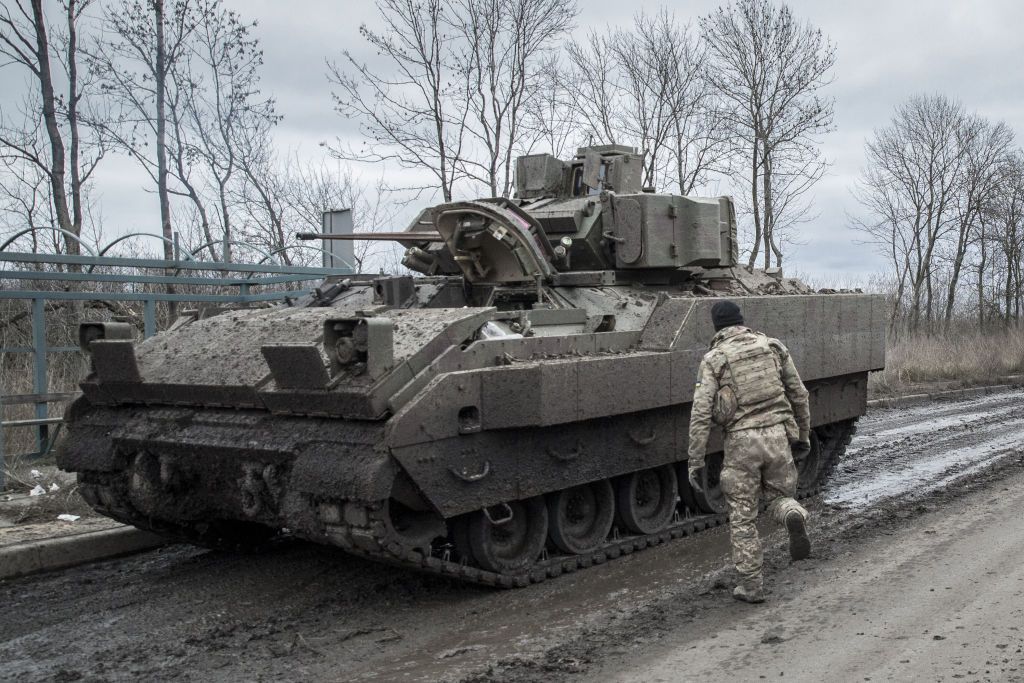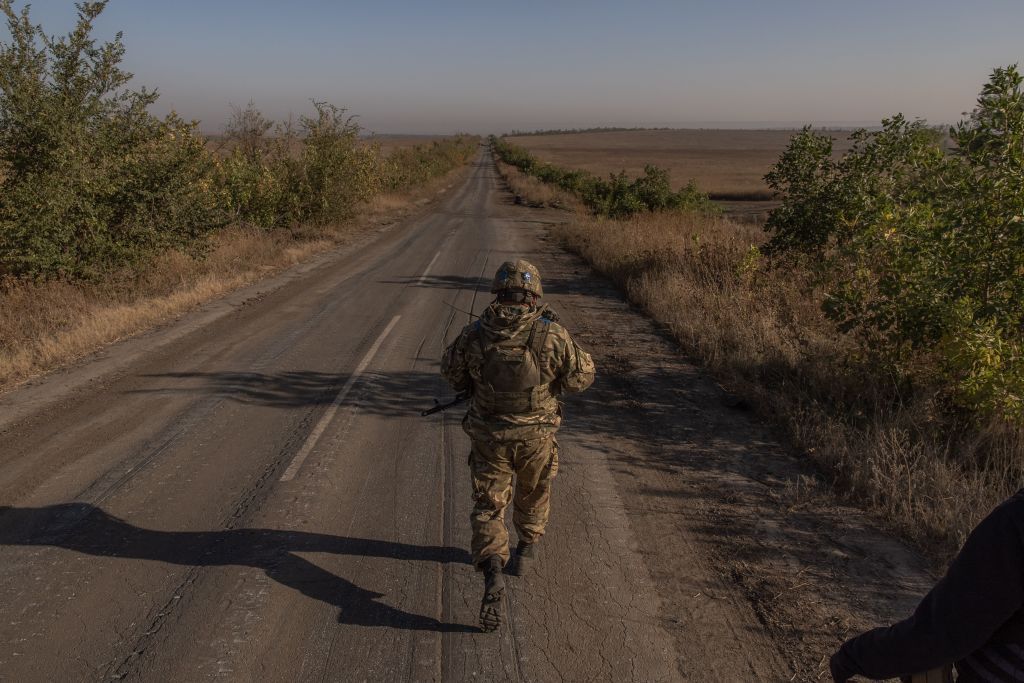Ukraine finally moves to fortify front line, but could it be too little too late?

“If you want to live, dig.”
The words, often spoken by Ukrainian troops, are universal advice for trench warfare in general, but especially for both sides in Russia’s war against Ukraine.
Normally expressed as advice to the individual soldier, the maxim now applies to the country as a whole.
Twenty-one months into the full-scale war, World War I-style tactics, with the high-tech edge brought by drones and other innovations, continue to dominate.
Russia and Ukraine are diving head-long into a winter campaign looking to be no less brutal than the last, and it is Russian forces that have taken the initiative on a wide stretch of the eastern front line and look likely to keep it for the foreseeable future.
As Ukraine wrestled with internal political tensions, the threat of Western military aid drying up, and the slow realization that the summer counteroffensive had ended in a strategic failure, questions began to be raised about Ukraine’s preparation for a long defensive fight.
On Nov. 24, Deputy Prime Minister and Digital Transformation Minister Mykhailo Fedorov announced the creation of a new working group headed by himself and Defense Minister Rustem Umerov to “coordinate the efforts of all authorities and the military in matters of construction of fortifications.”
Six days later, President Volodymyr Zelensky held a meeting with Umerov and other officials in Zaporizhzhia Oblast to discuss the building of fortifications, focusing on the most critical sectors of the front line, as well as the state border with Belarus, across which Russian forces launched their failed attempt to take Kyiv in February 2022. In a written statement, the Defense Ministry confirmed to the Kyiv Independent that plans are for fortifications to stretch along the entire line of contact.
But in contrast to Russia, which had spent months constructing its defensive lines while its own forces held the initiative over winter and spring, Kyiv did not take the same measures while Ukrainian forces were attacking over summer.
“Along almost all of the front line where we (Ukrainian forces) are located now, we have been there for no less than half a year,” said retired Ukrainian colonel and expert at the Center for Defense Strategies think tank Viktor Kivliuk to the Kyiv Independent.
“This has been going on for half a year and suddenly, the Supreme Commander-in-Chief (Zelensky) seems to wake up and propose building fortifications. Where was he all this time?”

Strategic defense
Heralded by the dramatic launch of a large-scale offensive on the city of Avdiivka in early October, Ukraine has entered the winter campaign squarely on the defensive.
Though Avdiivka remains a hotspot, fresh assaults have begun in other sectors, most notably, around Marinka and Bakhmut, where Russian forces have made significant gains for the first time in months.
In familiar style, Kyiv never declared its counteroffensive to be officially over, but the reality on the ground is difficult to deny.
In a Dec. 1 interview with BBC’s Ukrainian service, former Ukrainian General Staff Chief Viktor Muzhenko called for Kyiv to make a conscious shift to strategic defense, to regather and preserve its forces while holding back enemy advances.
“We need to reformat the front,” he said in the interview. “We need to create a powerful reserve, not only in quantity, but also in quality.”
“At the moment we cannot advance anywhere, everything that is happening is on such a small scale that it clearly won't lead neither to victory nor to the liberation of Ukrainian territory,” agreed Kivliuk. “We need a pause.”
Given this need, “the existence of pre-prepared and well-built lines of defense are critically important for the defense of Ukraine as a whole,” Kivliuk noted.
When defending against large-scale combined arms offensives in the positional warfare that has come to dominate in Ukraine, an important distinction exists between front-line positions in the immediate active combat zone, and pre-prepared fortified lines built further in the rear, out of range for most artillery pieces.
This difference was reflected in the joint announcements of the working group: responsibility for constructing the first line of the new defenses will lie upon the military units stationed in that area.
Most brigades of the Ukrainian Ground Forces typically have their own engineer battalions, while two dedicated engineer brigades and other separate units also operate under the Support Forces Command.
Despite these resources existing on paper, Ukrainian soldiers fighting on front-line hotspots have reported a common failure by command to prepare even the most basic of back-up trench lines behind the zero-line positions.
These basic errors were reported to the Kyiv Independent by several soldiers to have been made on the flanks of Avdiivka, where, despite heavy losses, Russian forces have advanced several kilometers in some areas.

The same problems are frequent further north in Bakhmut, according to a senior artillery commander posted near the city, who requested to keep his identity secret when discussing the topic.
“Neither fortified positions nor the second line are being prepared properly, nor are the villages that in the near future could be engulfed in active hostilities,” he said.
“When the Russians storm the trenches, our guys have nowhere to retreat and there are no positions to take; they have to dig trenches under machine gun and sniper fire, never mind artillery shelling.”
According to the commander, even when an order to dig is passed down, the undermanned and underresourced units are often not capable of carrying it out.
“The order is given by the sector commander, repeated by the battalion commander, and should be carried out by the company with his own people,” he said, “but there are hardly enough people or engineers to occupy the first line, let alone dig the second one.”
Painful lessons
The summer and autumn campaign in 2023 have been defined by the failure of Ukraine’s much-awaited counteroffensive to achieve strategically meaningful territorial gains.
On the axis of the front south of Orikhiv in Zaporizhzhia Oblast and on the way to occupied Tokmak and Mariupol, the village of Robotyne was meant to be taken in four days, according to Ukrainian plans wargamed together with the U.S. military detailed in a Dec. 4 Washington Post story.
Led by Western-trained and equipped brigades and backed by large commitments of artillery ammunition, Ukrainian forces nonetheless took 80 days to capture the now-ruined settlement, and failed to push more than a few treelines further south afterwards.
Blame for the failure, according to the Washington Post’s sources, was traded between Kyiv and Washington.
Beyond mistakes made in the planning and execution of the counteroffensive, one thing was objectively clear: Russia’s sprawling network of purpose-built defensive lines in southern Ukraine had done its job.
With plans for a large-scale Ukrainian counteroffensive telegraphed months prior, Russia began working on the fortifications well in advance, with satellite images of large anti-tank ditches, trench systems, and lines of “dragon’s teeth” beginning to appear in the first months of 2023.
Committing massive amounts of state resources, Russia expanded on its line of fortified lines, which had by then been named after general Sergey Surovikin, right up until the beginning of the Ukrainian offensive in June.
Following Soviet military doctrine of “defense in depth,” two main lines were built at intervals of 10-15 kilomteres behind the initial contact line, itself defended by kilometers of dense minefields.
After reaching the first of these lines in late August, soldiers reported to the Kyiv Independent of networks of tunnels and concrete-reinforced bunkers that were previously undetected by satellites.
Russia’s efficiency in planning and building the Surovikin Line did benefit from the authoritarian country’s simple vertical power structure, Kivliuk argued, but that excuse only goes so far to explain Ukraine’s failure to do the same.
“This is not about dictatorship or democracy,” he said. “Dictatorships will always be quicker in making decisions, but that difference is not the same when it comes to actually digging a trench.”
Delayed decision
The long lack of action from Kyiv has several plausible explanations.
Ukraine’s — and particular Zelensky’s — public-facing message still based around an unwavering intention to advance and liberate the rest of the occupied territories. Within that narrative, the optics of building extensive fortifications along the existing contact line evoke an admission of defeat of sorts; not only for this year’s counteroffensive but for hypothetical future ones.
In turn, building rear lines of defense tens of kilometers behind the contact line, as Russia did, feeds unsavory expectations of major new enemy gains in the future, in which front-line cities like Chasiv Yar, Toretsk or even Kupiansk could be lost.
Another reason floated is the lack of clear coordination and responsibility for such a large-scale task, and one that crosses the boundaries between Ukraine’s military and civilian leadership, where reports of tensions between Zelensky and Commander-in-Chief Valerii Zaluzhnyi continue to simmer.
These factors, among others, invariably meant that the decision only came as a reactive move to Russia’s new offensives, and one that could prove costly.
“I think only now have the country's top officials started to realize the mess that Ukraine is in at the moment,” said Yurii Nikolov, head of the investigative media project Nashi Hroshi (“Our Money”). “Of course it is better late than never but at face value it doesn't look good.”

In its statement, the Defense Ministry said that the decision to form the working group was made by Zelensky and executed by the Cabinet of Ministers.
As argued by Nikolov and other commentators, Fedorov’s presence as co-head of the group suggests that the move was unlikely to have been initiated by Zelensky.
Although the young minister has been directly involved in the war effort through drone initiatives and other technological innovations, he is an unexpected choice to lead such a group, while neither Zelensky in his role as Supreme Commander-in-Chief, Zaluzhnyi, or anyone else in the military leadership appears to have shown the urge earlier.
“What it looks like is that some people in the government structure had a good look at the dynamic on the front line and took the initiative to do this themselves,” Nikolov said, “and in this case it was Fedorov together with the Defense and Infrastructure ministries.”
The Digital Transformation Ministry confirmed to the Kyiv Independent that the ministry will not be directly involved in the fortifications work; that it will be only Fedorov himself involved in his role as co-head.
While not giving a direct reason about why this was all happening so late, the Defense Ministry’s comments did seem to appreciate the newly urgent need to get building.
“Work in this area has been carried out and will continue to be carried out,” the statement said. “We are working on reducing the time from the moment of decision-making to the construction of fortifications.”
Scramble to act
Despite the delay, the decision of the Ukrainian leadership to finally begin working systematically on fortified defensive lines gives hope that Ukraine will be able to better withstand what could be months of Russian offensive operations.
According to the Defense Ministry, the design of the fortifications will follow existing doctrine modified to be better prepared for the new challenges of this war.
“There are approved typical forms and designs of shelters and fire structures used on the line of defense,” the ministry said. “In addition, the works are being modernized and improved to better protect against the enemy's use of thermobaric munitions, FPV drones and cluster munitions.”
But beyond the design, the task at hand presents formidable challenges for Kyiv.
With winter only beginning, the freezing, hardening ground makes excavation works much more laborsome, especially the first-line positions dug by hand.
“In winter, digging a trench is almost impossible, the ground is hard, you can’t use picks, and the tractor won’t drive up,” said the commander near Bakhmut. “All you can do is occupy the ruins of buildings, if there are any, or dig inside existing shell-holes.”
Perhaps more daunting than the cold will be the organization of the work, with a plethora of government and military bodies involved and the financing plan largely unknown.
According to Fedorov’s initial announcement, while the first line will be built by the military, the second will be under the oversight of the State Agency for Restoration and Infrastructure Development, “through the involvement of private contractors.”
Private businesses have offered up financing for the initial phase of construction, Fedorov’s post added, without specifying how many funds had been raised or how the work will be funded beyond that point.

To make matters more complicated, the building of sporadic fortifications so far has, over the full-scale war, traditionally been the purview of Ukraine’s oblast administrations, which have received intermittent funding from the central government.
In the latest such allotment, the Zaporizhzhia Oblast regional administration received Hr 31.7 million ($856,000) for the building of fortifications. The announcement made no mention of Zelensky’s new orders or the working group.
“The allocation of funds shows that the work of the (joint working) group efficiently supports the provision of assistance, as was done in Zaporizhzhia Oblast,” said the Defense Ministry when asked if this money was part of the new fortifications scheme.
This tangled web of responsibility, Kivliuk warned, could offer ripe opportunities for corruption and negligence throughout the project’s structure.
“In the next half year I think we will see a large number of strange developments concerning the construction or non-construction of something here or there,” he said.
Now that the decision has been made, the next months will give more of an idea of how effectively the work will be carried out.
With a rock-solid defense being crucial to Ukraine’s fortunes in the war over 2024 and beyond, the stakes for this new project couldn’t be higher.
“We (Ukraine) will either be occupied or not, we will either live or be killed,” said Nikolov.
“For as long as we haven't been killed, we need to do something to save ourselves. If someone isn't doing what they are supposed to, but someone else is ready to do it, you need to help them and not get in their way.”
Note from the author:
Hi, this is Francis Farrell, cheers for reading this article. We are entering a new phase of the war, which could potentially be stranger, tougher, and more uncertain than it has ever been so far. I wrote earlier about the West's responsibility and failures regarding Ukraine's struggle for existence, but there is another side to this, the responsbility of Kyiv itself. In a time when instability around the world is growing, and attention is fading when it is needed the most, please consider supporting our reporting.














